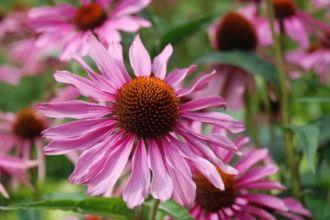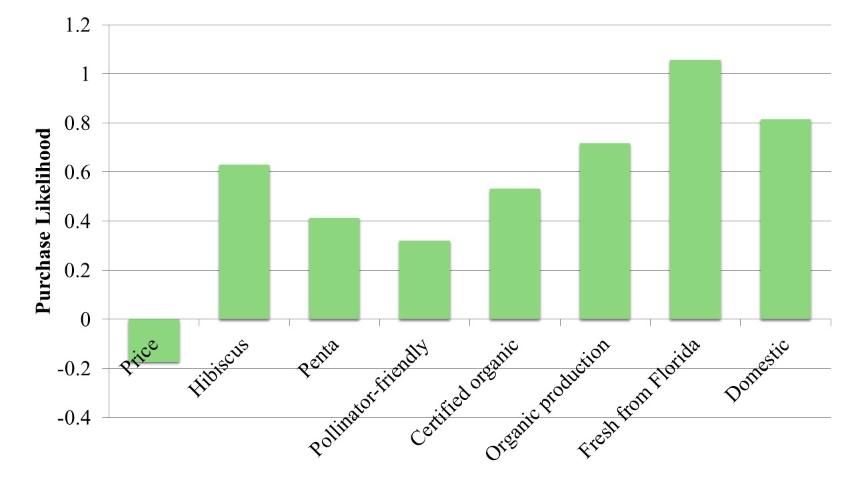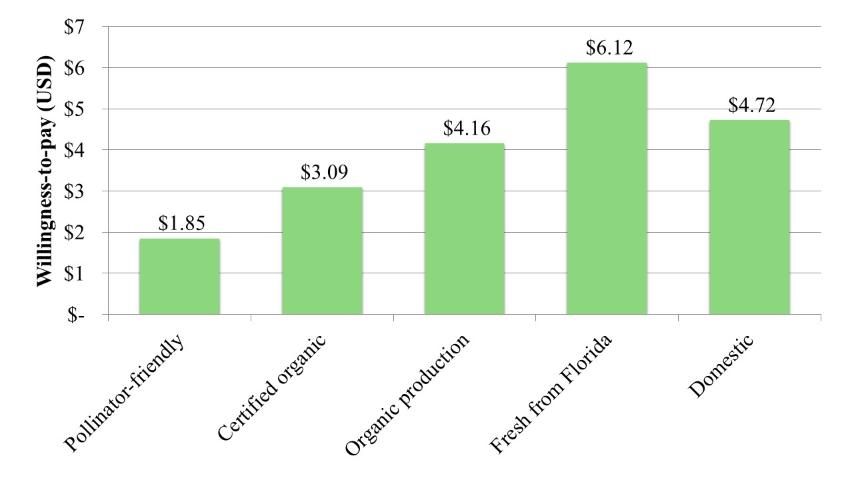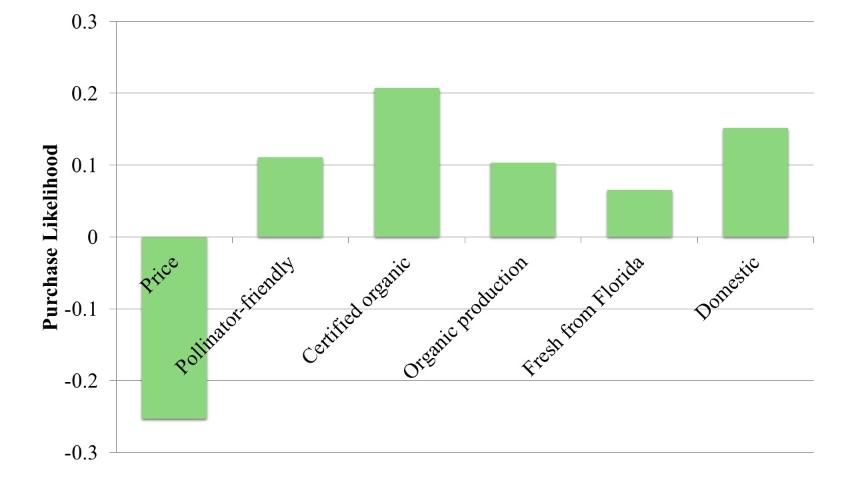Introduction
Ornamental landscape plants consist of annuals, perennials, trees, and shrubs that are primarily planted outdoors. Because they are planted outdoors, their impact on the environment and adaptation to local climatic conditions are important factors that may influence consumers' choices (Brand and Leonard 2001). Regarding environmental impacts, organic production methods are often perceived as being more environmentally friendly than conventional production methods (Campbell et al. 2015; Yue et al. 2011). Locally grown plants are also perceived as more environmentally friendly (due to less transportation) and more adaptable to local climatic conditions (Brand and Leonard 2001; Yue et al. 2011). Consequently, there is potential for these attributes to impact consumer purchasing behavior. This article assesses the impact of price, plant type, pollinator friendliness, production methods, and origin attributes on consumers' purchasing likelihood for ornamental landscape plants. Recommendations for green industry stakeholders are also provided.

Credit: USDA
Methodology and Summary Statistics
Data were collected through surveying Florida plant consumers in 2014. During the experiment, respondents viewed images of landscape plants and rated their purchase likelihood on a scale of 1 to 7 (1=very unlikely; 7=very likely). In each image, the attributes of the plants varied and were presented using in-store signs (Figure 1). A complete list of plant attributes and attribute levels is presented in Table 1. As respondents determined their likelihood of purchase, their eye movements were recorded to assess their visual attendance to the attributes and how that influenced their behavior (Figure 2). After viewing the plant images, respondents completed a questionnaire containing background, preference, and sociodemographic questions. Survey participation lasted approximately 30 minutes, with participants being compensated $30 for their time.
![Figure 1 Figure 1. An example of a plant image used to evaluate consumer purchasing likelihood for ornamental landscape plants. (Note: Attribute sign order was randomized to reduce any order effect on eye movements. The attribute sign text color [i.e., blue] was selected to match the Fresh from Florida logo to improve visual consistency.)](/image/FE1000/15386204/6748531/6748531-2048.webp)

A total of 108 adults participated in the survey study. Respondents' average age was 53 years old, with 61% females and 39% males. The average household size was 2 people, and the average household income was between $51,000 and $60,000. In addition, 32% had completed a bachelor's degree.
Results
In this section, we cover the impact of plant attributes on purchase likelihood, premiums consumers are willing to pay, and their visual attention to the attributes.
Plant Attributes
Consumers consider both physical (i.e., plant type, color, etc.) and credence attributes (those that are not readily apparent from viewing the plant, such as origin, production method, etc.) when deciding on which products they will purchase. This study primarily investigated credence attributes that were presented on above-plant signs. Unsurprisingly, results show that as the plant prices increase, consumers' purchase likelihood decreases (Figure 3). Intuitively, this makes sense because many consumers seek out the "best deal" when purchasing products. Regarding origin attributes, Fresh from Florida positively influences consumer purchasing behavior, followed by domestic origins. Plants from closer-located origins are likely preferred due to perceptions of helping the local economy/community, decreased transportation/pollution, improved quality, and adaptability to survive local environmental/pest problems (Brand and Leonard 2001; Yue et al. 2011). When considering production methods, many consumers are more interested in organic production methods (both certified and noncertified) than in conventionally produced plants. Likely, this is due to the perception of organic production being better for the environment (Campbell et al. 2015; Yue et al. 2011). Regarding plant type, consumers are more likely to purchase hibiscus and pentas than petunias. Consumers are also interested in plants that are pollinator-friendly due to concerns about the decline in pollinator insects, an issue that has vast global economic and food production implications (Klein et al. 2007).

Premiums
Using the attribute results, we estimated premiums that respondents were willing to pay for plants with the different attributes. Premiums were defined as the prices respondents were willing to pay above those for similar plants with only base attributes. Base attribute levels included import for origin source, conventional production for production method, and not rated for pollinator friendliness. Additionally, due to the hypothetical nature of the experiment, it is important to note that the premiums generated in this study should be interpreted as guidelines of consumer valuation rather than an exact amount consumers are willing to pay. Results show that when compared to imported plants, consumers are willing to pay the greatest premium ($6.12) for Fresh from Florida plants, followed by domestic plants ($4.72) (Figure 4). Compared to conventional plant production, consumers are willing to pay $4.16 more for plants grown using organic production methods and $3.09 more for certified organic landscape plants. Consumers are willing to pay a $1.85 premium for landscape plants whose pollinator friendliness is promoted compared to plants not labeled for that attribute. Overall, the premium results indicate that consumers place the greatest values on in-state and domestic origins, organic production methods, and pollinator-friendly plants. Each of these attributes presents a possible means of differentiating the products and improving their value to the end-consumers. Promoting these attributes could influence plant selection and positively impact demand.

Visual Attention to Landscape Plant Attributes
Because credence attributes are communicated to consumers via in-store promotions and oftentimes retail settings include lots of visual clutter (i.e., signs, products, etc.), we also investigated the impact of visual attention to the attributes based on consumers' purchase likelihood. Several research studies have shown that consumers "visually attend" to information that is relevant to their task (in this case, determining their purchase likelihood) (Orquin and Loose 2013). Fixation counts (the number of times a consumer's eyes fixate on the attribute) were used to determine visual attention to plant attribute signs. Positive values indicate that fixations (i.e., visual attention) increased consumers' purchase likelihood while negative values indicate fixations decreased consumers' purchase likelihood.
In this study, visual attention to price decreased consumers' purchase likelihood (Figure 5). This was to be expected because price strongly influences choice. Visual attention to the other attributes increased consumers' purchase likelihood, with certified organic having the greatest impact, followed by domestic origin, pollinator-friendly, organic production, and Fresh from Florida. Interestingly, Figure 6 shows that consumers visually attended to the plant signs more than the plants themselves. Likely, this reflects increased processing due to reading the attribute signs rather than just viewing an image (Orquin and Loose 2013). Overall, these results emphasize the need to have highly visible, attractive in-store promotions for beneficial plant attributes in order to attract consumers and influence their behavior. Conversely, price tags should be present but should not be the key focal point.

Recommendations to the Industry
In-store labeling of credence attributes is a great way to inform consumers and add value to ornamental plants. This study identified several credence attributes that consumers value and view when determining their purchase likelihood for ornamental plants. First, origin strongly impacted consumers' purchasing behavior. When possible, green industry professionals (i.e., growers, wholesalers, and retailers) should source plants from in-state and domestic suppliers. Plant sources should be promoted when selling in-state or domestic plants. Often using a state promotional program (e.g., Fresh from Florida) is beneficial due to increased brand awareness from extensive marketing campaigns and promotional materials.
![Figure 6 Figure 6. Heat map demonstrating visual attention (i.e., fixation count concentration) on the image [n=108] from Figure 1. (Note: Red coloration indicates areas of highest concentration, followed by yellow and green.)](/image/FE1000/15386204/15475389/15475389-2048.webp)
Another attribute that consumers are interested in is pollinator-related promotions (or pollinator-friendly) for ornamental landscape plants. Pollinator-friendly plants should be clearly indicated using in-store promotions. Promotions can be used to explain which pollinators benefit from the plants and how this is accomplished (e.g., adult food, larva food, habitat, etc.). Additionally, promotions can be used to educate consumers about proper pesticide use and landscape design to improve pollinator health.
Production methods also influenced consumers' purchasing decisions. The study showed that that consumers prefer certified organic and organic production methods. To increase their profits, producers should evaluate their production strategies to identify economically feasible means of increasing sustainability (e.g., organic production). In-store promotions can be used to identify plants grown using sustainable/organic production methods. The benefits offered from these production methods should also be highlighted through educational promotions.
In addition, visual attention results indicate that in-store promotions of the beneficial attributes positively impact consumers' purchasing behavior. In-store promotions that highlight these attributes and their benefits to the consumer are a valuable means of influencing consumer choices. Because prices and visual attention to prices negatively impact purchasing behavior, retailers should clearly mark prices but not emphasize them in their in-store promotions. Let the plants themselves and their attributes, rather than the price points, draw consumers to the plants.
References
Brand, M. H., and R. L. Leonard. 2001. "Consumer product and service preferences related to landscape retailing." HortScience 36:1111–1116.
Campbell, B., H. Khachatryan, B. K. Behe, J. H. Dennis, and C. R. Hall. 2015. "Consumer perceptions of eco-friendly and sustainable terms." Agricultural and Resource "Economics Review 44:21–34.
Klein, A-M., B. E. Vassiere, J. H. Cane, I. Steffan-Dewenter, S. A. Cunningham, C. Kremen, and T. Tscharntke. 2007. "Importance of pollinators in changing landscapes for world crops." Proceedings of the Royal Society. DOI: 10.1098/rspb.2006.3721.
Orquin, J. L., and S. M. Loose. 2013. "Attention and choice: A review on eye movements in decision making." Acta Psychologica 144:190–206.
Yue, C., J. H. Dennis, B. K. Behe, C. R. Hall, B. Campbell, and R. G. Lopez. 2011. "Investigating consumer preference for organic, local, or sustainable plants." HortScience 46:610–615.